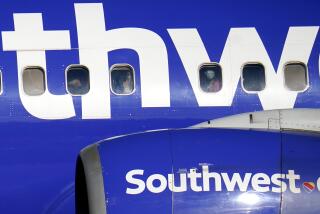On the Spot: The FAA, not United, sets the rules for pets that fly
- Share via
Question: I’m flying round-trip from Los Angeles to Denver, and after buying my ticket for $240 on United, I thought I would take my 5-pound dog with me. I was told it would be $125 each way. If I’m going to pay that much, I figure I might as well buy her a seat so I can strap her metal crate onto the seat. When I inquired about buying a second seat, I was told I could not do that. So what gives?
Jill Kessler
Pacific Palisades
Answer: Of course, you can buy a second seat. It’s just that the dog will have to ride under that seat, and you’ll have to pay $240 for the seat and $250 round-trip for the pet fee. What you’ll be doing is paying $240 for legroom. In as much as legroom is kind of a joke on an airplane, the airline will have the last laugh on you. Just like always.
In this case, however, it’s not United being a hard case. It’s the Federal Aviation Administration. Here is what its regulations say: “If an airline does allow you to bring your pet into the cabin, we consider your pet container to be carry-on baggage and you must follow all carry-on baggage rules....Your pet container must remain properly stowed the entire time the airplane is moving on the airport surface, and for takeoff and landing.”
Some celebripets do get special treatment, but chances are you and yours aren’t going to be among them, unless your canine is the Westminster champ.
So what about stuffing Fido in a bag and sneaking him or her on? Bad idea, says Sandy Robins, an author and a pet lifestyle expert in Orange County, who points out that animals on flights sometimes can develop health issues, exacerbated by the stress of travel. If you’ve followed procedures, “if you do have some kind of issue, you can get some … help” in the air, she notes. And, she adds, don’t forget that some people have severe animal allergies. It’s hard to look innocent when your seatmate is sneezing his head off.
The goal, really, is to make the animal as comfortable as possible. Megan Blake, a pet lifestyle coach in Malibu, encourages owners to get their pets familiar with the transport container “so they think that is their safe place or safe haven.” And, she adds, don’t start the acclimation process the day before; give it some time. Putting something in there with your scent on it will help.
Heidi Ganahl, chief executive and founder of Camp Bow Wow, which offers day and overnight care, emphasizes trying to keep the pet’s schedule the same, which includes “feeding him at the same time and always making sure he stays as close to his routine as possible.”
All three emphasize the importance of hydrating your pet (just like yourself — air aloft really takes it out of you) — and not feeding your charge the morning of the flight.
It takes planning and patience to deal with a dog or a cat in the air. It can be frustrating, crazy-making and expensive — sort of like traveling with a kid, whom you can’t put in a crate and shove under the seat. Alas.
Have a travel dilemma? Write to [email protected]. We regret we can’t answer every inquiry.
More to Read
Sign up for The Wild
We’ll help you find the best places to hike, bike and run, as well as the perfect silent spots for meditation and yoga.
You may occasionally receive promotional content from the Los Angeles Times.






